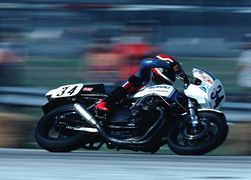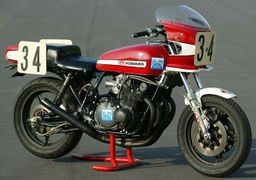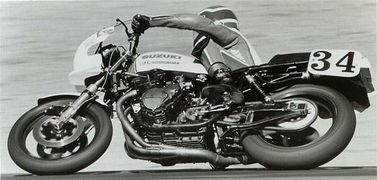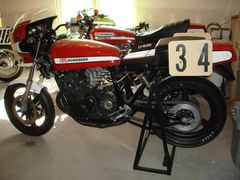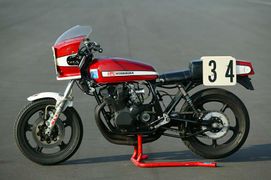Difference between revisions of "Suzuki GS1000 AMA Superbike"
| Line 41: | Line 41: | ||
|competition = | |competition = | ||
}} | }} | ||
Sometimes you win, sometimes you lose. This bike did bothin | Sometimes you win, sometimes you lose. This bike did bothin | ||
the same race. The year was 1980, and AMA Superbike racing was reaching its | the same race. The year was 1980, and AMA Superbike racing was reaching its | ||
first crossroads. After four years as a national-championship class, Superbike | first crossroads. After four years as a national-championship class, [[Superbike]] | ||
was graduating from a series based mostly on | was graduating from a series based mostly on [[BMW]]s, [[Moto Guzzi]]s and [[Ducati|Ducatis]] to a championship with serious attention from the Japanese Big Four. | ||
championship with serious attention from the Japanese Big Four. | |||
By that watershed year, when Wes Cooley rode this machine, performance-company | By that watershed year, when Wes Cooley rode this machine, performance-company | ||
Yoshimura had teamed up with Suzuki in a partnership that continues 20 years | [[Yoshimura]] had teamed up with Suzuki in a partnership that continues 20 years | ||
later. Meanwhile, Honda and Kawasaki fielded their own factory teams. | later. Meanwhile, [[Honda]] and [[Kawasaki]] fielded their own factory teams. | ||
Cooley, the defending Superbike champion, dueled that season for 10 races with a | Cooley, the defending Superbike champion, dueled that season for 10 races with a | ||
pair of young racers you may have heard of: Eddie Lawson and Freddie Spencer. | pair of young racers you may have heard of: [[Eddie Lawson]] and [[Freddie Spencer]]. | ||
Going into the season finale at Daytona, Lawson and Spencer each had three | Going into the season finale at Daytona, Lawson and Spencer each had three | ||
| Line 62: | Line 58: | ||
length to be declared the series champion. | length to be declared the series champion. | ||
Then Lawson protested | Then Lawson protested Cooley's bike, saying the frame had been illegally | ||
modified. Officials on the scene upheld the protest, and Lawson was declared the | modified. Officials on the scene upheld the protest, and Lawson was declared the | ||
champion. | champion. | ||
Then things really got complicated. Cooley countered that Lawson had started the | Then things really got complicated. Cooley countered that Lawson had started the | ||
race | race illegally riding teammate Dave Aldana's bike when his own engine blew up. | ||
Eventually, the matter went to an appeal board, which ruled that Lawson was not | Eventually, the matter went to an appeal board, which ruled that Lawson was not | ||
a legal entrant in the race and | a legal entrant in the race and couldn't protest Cooley. The board also ruled | ||
that | that Cooley's modifications, while on the edge of the rules, were legal. | ||
So while it took till December of that year, Cooley eventually won his second | So while it took till December of that year, Cooley eventually won his second | ||
Superbike | Superbike title a second time. | ||
But | But there's even more to the story. The lasting impact of that season was the | ||
realization that Superbike had become a major factory battleground, with plenty | realization that Superbike had become a major factory battleground, with plenty | ||
of corporate pride on the line. As a result, new rules and enforcement policies | of corporate pride on the line. As a result, new rules and enforcement policies | ||
Revision as of 18:27, 21 June 2019
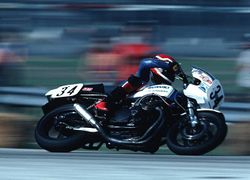 | |
| Manufacturer | Suzuki |
|---|---|
| Also called | Suzuki GS 1000 AMA Superbike |
| Production | 1980 |
| Class | Racing |
| Manuals | Service Manual |
| Tech Specs · Brochures · Reviews · Ads · Videos | |
Sometimes you win, sometimes you lose. This bike did bothin the same race. The year was 1980, and AMA Superbike racing was reaching its first crossroads. After four years as a national-championship class, Superbike was graduating from a series based mostly on BMWs, Moto Guzzis and Ducatis to a championship with serious attention from the Japanese Big Four.
By that watershed year, when Wes Cooley rode this machine, performance-company Yoshimura had teamed up with Suzuki in a partnership that continues 20 years later. Meanwhile, Honda and Kawasaki fielded their own factory teams.
Cooley, the defending Superbike champion, dueled that season for 10 races with a pair of young racers you may have heard of: Eddie Lawson and Freddie Spencer.
Going into the season finale at Daytona, Lawson and Spencer each had three victories, while Cooley had two. In the end, Cooley beat Spencer by half a bike length to be declared the series champion.
Then Lawson protested Cooley's bike, saying the frame had been illegally modified. Officials on the scene upheld the protest, and Lawson was declared the champion.
Then things really got complicated. Cooley countered that Lawson had started the race illegally riding teammate Dave Aldana's bike when his own engine blew up.
Eventually, the matter went to an appeal board, which ruled that Lawson was not a legal entrant in the race and couldn't protest Cooley. The board also ruled that Cooley's modifications, while on the edge of the rules, were legal.
So while it took till December of that year, Cooley eventually won his second Superbike title a second time.
But there's even more to the story. The lasting impact of that season was the realization that Superbike had become a major factory battleground, with plenty of corporate pride on the line. As a result, new rules and enforcement policies were put into effect that have grown to give AMA Superbike racing the tightest tech enforcement in the motorcycle-racing business.
Source Road Test
Photos
